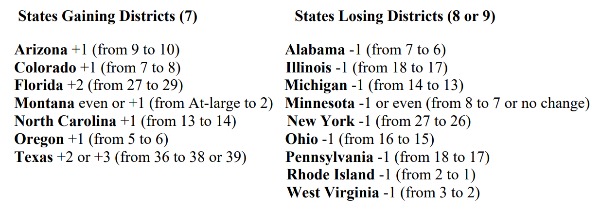People flocking to low-tax states could swing future elections
Just a month ago, as friends and families prepared to gather for the holiday season, the men and women at the U.S. Census Bureau were busy releasing their latest annual estimates of population changes across the United States.
With the hustle and bustle of the season, many Americans missed the important new data. The new census estimates detail how states have grown since the last full census in 2010. The estimates provide some fascinating insight on what we can expect from the quickly approaching 2020 Census.
For those of us wonky enough to follow the annual trends in state-by-state migration, the numbers were an early Christmas gift.
{mosads}A report I have authored with Arthur Laffer for the past decade, “Rich States, Poor States,” has tracked this movement, as Americans “vote with their feet” across state lines. Our research provides policymakers timely data linking migration to state-level policy decisions and economic competitiveness.
In general, states that keep taxes low and provide a competitive business climate perform far better than the states that follow the tax-and-spend approach.
In terms of overall population changes over the past year, that finding is once again confirmed. The United States has grown to nearly 327 million residents, with highly competitive economies in Idaho, Nevada and Utah leading the way this past year in percentage growth.
It is important to note that overall population growth takes into account several factors, including: birth rates and death rates, international immigration and domestic migration. This data provides a key barometer for policymakers as states compete for the Americans who continue to “vote with their feet” and move from state to state for greater economic opportunity.
At least once a decade, the political class in Washington pays close attention to these state population flows, as the numbers will alter the makeup of congressional seats during the once-in-a-decade process of reapportionment and redistricting.
Seats in the U.S. House of Representatives are apportioned based on the total number of residents within a state. In addition, congressional apportionment affects the Electoral College, which could swing future, close presidential elections. There are several methods that the firm, Election Data Services, uses when attempting to estimate which states will be the big winners and losers of the 2020 Census.
The new 2017 Census estimates can be used to give us a year-over-year change from 2016 or, alternatively, estimates can be based on a longer-trend line. The data gives a nice summary of estimates for congressional seat changes after the 2020 Census.
Source: Election Data Services
The state with the largest downside risk appears to be Illinois, which will lose one congressional seat in 2020 and is in danger of being the only state in the U.S. to lose two seats.
Illinois suffered the largest net population loss of any state in the past year, and due to that loss, it was overtaken by Pennsylvania this year as the fifth-largest state in the country. Major tax increases passed in 2017 will certainly not help this downward economic spiral.
The 2017 Census estimates also contain some troubling news for the nation’s largest state, California. While the 2010 Census was the first in state history to not add an additional congressional seat, 2020 could be worse for the Golden State.
Some current projections show high-tax California is on the bubble to actually lose a congressional seat in 2020 — a shocking development for a state that gained seven seats between 1980 and 1990 alone.
For history buffs, it is possible that high-tax Rhode Island will lose one of its two congressional seats in 2020. That will be the first time since 1789 that Rhode Island only has one congressional seat.
Meanwhile, another state with extremely high tax burdens, New York, is set to lose yet another seat in 2020, the eighth census in a row that the Empire State has forfeited seats. Going back to the 1940 Census, New York is currently down 18 congressional seats on net. The new count in 2020 would add to that alarming trend.
On a more optimistic note, a duo of no-income tax states (a key factor in economic competitiveness), Florida and Texas, are the likely big winners in 2020. Current projections have Florida gaining two new seats, with Texas likely set to gain two to three new seats.
This is a continuation of long term trends for both states. Texas has gained seats every census since 1940, while Florida’s uninterrupted streak extends back into the 19th century.
Americans are voting with their wallets in response to policy decisions and state competitiveness. The new census migration data reveals that millions of people are moving their families, businesses and incomes to states that are more economically competitive.
This country has always been the land of opportunity, offering newly arriving immigrants the chance to live the American Dream. Sometimes it’s easy to forget the magnitude of the migration within our own borders for similar reasons.
People choose to move from state to state for all sorts of reasons, like proximity to family members and better weather, but migration to pursue economic opportunity is a key take away from a decade of our research in “Rich States, Poor States.”
It really all goes back to economics 101. When you tax something, you get less of it, and when you tax something less, you get more of it. Pro-growth policies, such as lighter tax and regulatory burdens, boost state economic activity and attract citizens looking to enhance their wellbeing.

The 2017 Census estimates provide a clear manifestation of how states with competitive, free-market policies continue to win the day.
Jonathan Williams is chief economist at the conservative American Legislative Exchange Council and vice president of its Center for State Fiscal Reform. Follow him on Twitter @taxeconomist.
Copyright 2023 Nexstar Media Inc. All rights reserved. This material may not be published, broadcast, rewritten, or redistributed. Regular the hill posts









